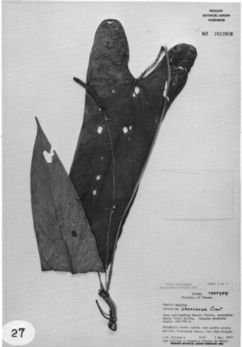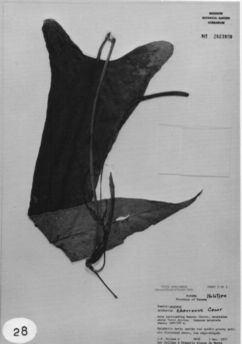


Anthurium chorranum Croat, sp. nov.
TYPE: Panama. Panama: Serrania de Canasas, area surrounding Rancho Chorro, mountains above Torti Arriba, 400-700 m, Folsom et al. 6640 (MO 2623909, holotype; PMA, isotype).
Planta epiphytica; internodia usque 3 cm longa aut longiora; cataphyllum persistens intactum, denique deciduum; petiolus 29-35 cm longus adaxialis complanatus; lamina modice membranacea, anguste triangularis ad anguste hastato-triangularis, basi cordata, 45-49 cm longa, 13-16.5 cm lata; inflorescentia plus minusve erecta; pedunculus 18-21 cm longuslens; spatha modice membranacea, viridis, oblongo-lancco-lata, ca. 6-8 cm longa, 8 mm lata; spadix viridis. 6-8.5 cm longus; baccae ignotae.
Epiphyte; stem ca. 1 cm diam.: internodes to 3 cm or more long; leaf scars inconspicuous: roots few per node, slender and elongate; cataphylls moderately thick, to 11 cm long, remaining intact, soon deciduous.
LEAVES with petioles 29-35 cm long, flattened adaxially with low erect margins; geniculum ca. 1.5 cm long; blades moderately thin, narrowly-triangular to narrowly hastate-triangular, narrowly acuminate at the apex (the acumen flat), prominently lobed at the base, 45-49 cm long, 13-16.5 cm wide, broadest at the base; anterior lobe 43-44 cm long, the margins almost straight to concave, posterior lobes 8-9.3 cm long (from apex of sinus to tip of lobe), directed downward to outward at ca. 45¡ angle, narrowly rounded at base; the sinus arcuate or hippocrepiform to parabolic, 3.5-6 cm deep; both surfaces drying matte, slightly paler below; midrib narrowly raised on both surfaces; basal veins 4 or 5 pairs, the first and second pairs free or nearly so, the remainder coalesced ca. 1.5 cm, naked; primary lateral veins 9-12 per side, departing the midrib at 45-60¡ angle, arcuate to the collective vein, drying moderately obscure above, prominent below; interprimary and secondary veins mostly less prominent than the primary lateral veins; collective vein arising from the first or second basal vein but some of the lower basal veins loop-connecting with the collective vein, moderately straight or weakly loop-connecting the primary lateral veins, 3-5 mm from the margin, weakly sunken above, raised below.
INFLORESCENCE semierect; peduncle 18-21 cm long, 2-3 mm diam., terete; spathe moderately thin, green with dense raphide cells visible, oblong-lanceolate, 6.8 cm long, ca. 8 mm wide, broadest near the base, narrowly long-acuminate at apex, rounded at base, inserted at ca. 45¡ angle on peduncle; stipe to 2 mm long; spadix green, scarcely tapered, 6-8.5 cm long, 4-5 mm diam.; flowers rhombic, ca. 2 mm long, 1.5 mm diam., ca. 5 flowers visible in the principal spiral, 6-8 flowers visible in the alternate spiral, tepals weakly glossy on drying, yellowish brown, the lateral tepals 1 mm wide, the inner margin broadly rounded; pistils not emergent; stamens persisting in a tight cluster over the pistil; anthers ovoid, ca. 0.5 mm long.
INFRUCTESCENCE not seen. Figs. 27 and 28.
Anthurium chorranum is known only from the type collection from Panama in the Serrania de Canasas in southeastern Panama Province at 400 to 700 m in what is probably tropical wet or premontane rain forest.
The species is perhaps best placed in section Polyneurium and is distinguished by its slender stems, its somewhat elongate internodes, its intact, deciduous cataphylls, and by its moderately thin, narrowly triangular to narrowly hastate-triangular blades. It is apparently related to Anthurium niqueanum from the Serrania de Pirre with which it shares elongate internodes, intact, deciduous cataphylls, and a similar blade shape. The latter differs, however, in having a thicker blade with much more prominent veins and in having stems, petioles, and peduncles with a thin waxy layer.
The name of the species refers to the type locality at Rancho Chorro.
 |
 |
Panama: Serrania de Canasas, above Torti Arriba, Folsom et at. 6640 (MO, PMA).